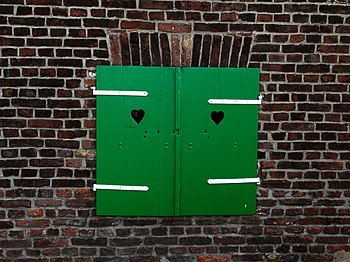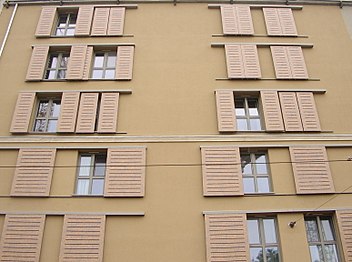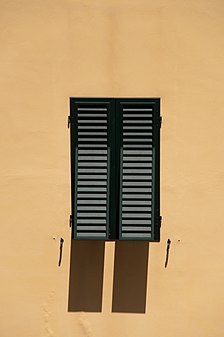Shutter

A shutter is a portable device, usually a rotatable flap which on buildings often, rare inside next to the outside windows is mounted so that it can close with its help the window opening.
description
A shutter is made of hard-wearing material, mostly treated wood , and is often provided with slanted openings or slats through which daylight can enter. In isolated regions of Germany it is also Klappladen (Bavaria and Baden-Wuerttemberg), shock loading (in North and West Germany) or turning shop (new federal states) in Austria window bar called. A rotating shutter is usually divided into two parts, more rarely one part. It is called a folding shutter in several parts . A shutter that can be moved parallel to the facade is a sliding shutter . When open, the shutter is fixed by a shutter holder.
The shutter was originally installed to protect the interior from wind and weather. With the introduction of the window glass , the shutter was used to protect the window pane. Today it is mainly used as a privacy screen, to darken the interior or for decorative purposes. Since it can be locked, it also acts as a burglar protection. In southern countries, shutters also serve as sun protection.
The connection with the building is made with the help of so-called clamps , which belong to the category of shutter fittings. In Bavaria it is primarily mounted on the frame; the so-called Bavarian attack. In Baden-Württemberg and Switzerland mainly in the reveal. North of the Main line in front of the masonry. The best assembly according to today's standards is in the reveal. Here the shutter is almost flush with the brickwork. The gap between the shutter and the reveal is only approx. 4 mm. In contrast, the Bavarian stop between 5 cm and 7 cm. In addition, the installation in the reveal offers additional protection against break-ins, since the window or folding shutter cannot be levered out of the clamp when closed, as it hits the reveal after 4 mm.
The function of privacy protection ( blinds ) is now largely taken over by the roller shutter , which has largely replaced the window shutter in new residential buildings in Germany over the past few decades. Some companies, mainly from southern Germany and near the border, have specialized in shutters for decades. The trend is now away from wood to easy-care and durable aluminum shutters. Painting is no longer done with conventional paint, but with modern powder coating , which is even possible with a wood structure look. Modern shutter fittings (system hinges) facilitate assembly.
Crank drives (internal drives, crank openers) allow opening from the inside. These can also be equipped with a motor.
Garage
A shutter (also outdated abattant ; Italian Persiana ; French Persienne ) is a folding shutter or roller shutter that can be displayed . On the one hand, the shop provides shade in summer and, on the other hand, allows fresh drafts into the apartment.
Persiana in Tuscany
Ornamental shop
As decorative shutters refers shutters that are connected without function fixed to the facade. They do not have a folding function, but usually fulfill a purely decorative task. The best-selling version of decorative shutters are plastic decorative shutters. This version is provided with keyhole bores from the rear and can easily be attached. Since there is no maintenance work required in the limited life of the plastic, they are very popular. Since decorative shutters do not have complex folding mechanisms, they are usually cheaper to manufacture and purchase than conventional shutters. Ornamental shutters can also be made of wood , aluminum or wood-like materials ( MDF ). For further decoration there are blind hinge and retainer dummies, which reinforce the illusion of real shops.
See also
Web links
Individual evidence
- ↑ sliding shutters Baunetzwissen, accessed 5 February 2010








